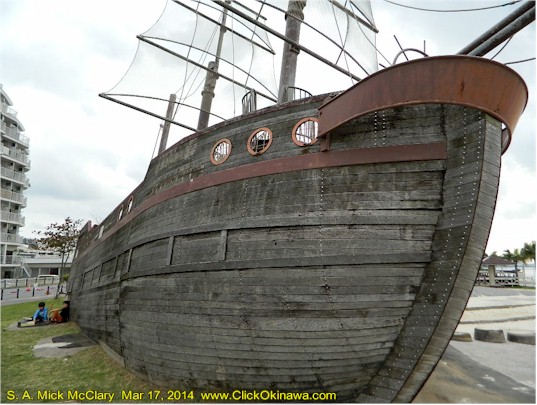|
The Indian Oak

If you visit Araha beach in Chatan, Okinawa, you will find children going down slides and climbing the rope ladders on an elaborate playground ship. Unless someone takes the time to read the plaque off to one side, no one would guess that this attraction is actually a life-sized replica of the Indian Oak; a ship that wrecked very near where this playground ship rests. Today, kids and the
Americans stationed in the nearby military bases love the ship. Facebook is full of photos of happy children and young lovers posing in front of this ship, but the Chatan old-timers feel a dark chill whenever they hear about it, and they do everything to avoid this beach. The modern "sanitized" telling of this tale has the English ship washing up on shore during a terrible typhoon on the night of August 14, 1840. The local Chatan villagers cared for the shipwrecked foreign sailors. Normally when a ship ran aground in shallow water, the crew would expect the cargo to be looted by villagers, but in this case the entire cargo was salvaged, and all 67 of the ship's crew were saved. After the storm, the villagers helped the crew to build a new ship using timbers recovered from the wreck. This was back before Japan had opened its borders to the outside world. When mainland Japan heard of the shipwrecked survivors on Okinawa, they sent samurai to come and execute the British trespassers. The samurai would have carried this plan out if the Okinawa natives hadn't stepped in to protect the English survivors, promising that once the ship was built, they would all be on their way. No need for bloodshed existed. The samurai were impressed with their conviction and relented.
|
....... |
This is a nice story, but not entirely what happened. According to Miyoko Ando, a 98-year-old resident of Chatan who first heard the real story as a child from her grandmother, the truth is much darker. In her telling of this tale, the Indian Oak did not wash up on the beach, but was helplessly caught up on the reef 100 meters out from the shoreline. The water there was shallow; and a man could nearly wade to shore from there, but this typhoon was a particularly strong one, and the waves were monstrous. The villagers used canoes and ropes to rescue most of the crew. However, one man named Boyd (perhaps the name was "Bird", it was difficult to understand Ando-san's pronunciation) was helplessly pinned, or caught in the ships rigging. The rough seas made it impossible to reach, or free him, though numerous attempts were made. Eventually he drowned as the ship broke up, but not until everyone was chilled to the bone by his loud pleas that had turned to screams, which towards the end had turned to curses. Even the people standing on shore could hear the desperate cries for help over the howling wind. In the morning, after the storm had passed, villagers attempted to recover Boyd's body, but it was nowhere to be found. A year later, after all the British sailors had long left Chatan , another storm struck the island. One old woman said that she could hear screams coming out from the ocean. She couldn't understand the voice because it was in English. No one else in the village could hear any yells. They looked for anyone out on the sea, but no one was there, so they assumed the old woman's ears were playing tricks on her. Four days later the woman was found dead in her futon. She was very old, so no one was surprised by her passing, but the odd thing was that she had foamy seawater in her throat and mouth. A few years afterwards another typhoon struck. This time it was a young boy who could hear the screams that no one else could hear. Four days later his mother found his dead body in his bed, and just like the old woman, he had seawater in his mouth. For several years, every time an August storm hit the island, someone would be sure to hear Boyd still screaming for a rescue that never comes. Four days later that someone would be found dead in their beds.
Dutcher, Ron (2013-01-13). Okinawa Kwaidan, True Japanese Ghost Stories and Hauntings
|